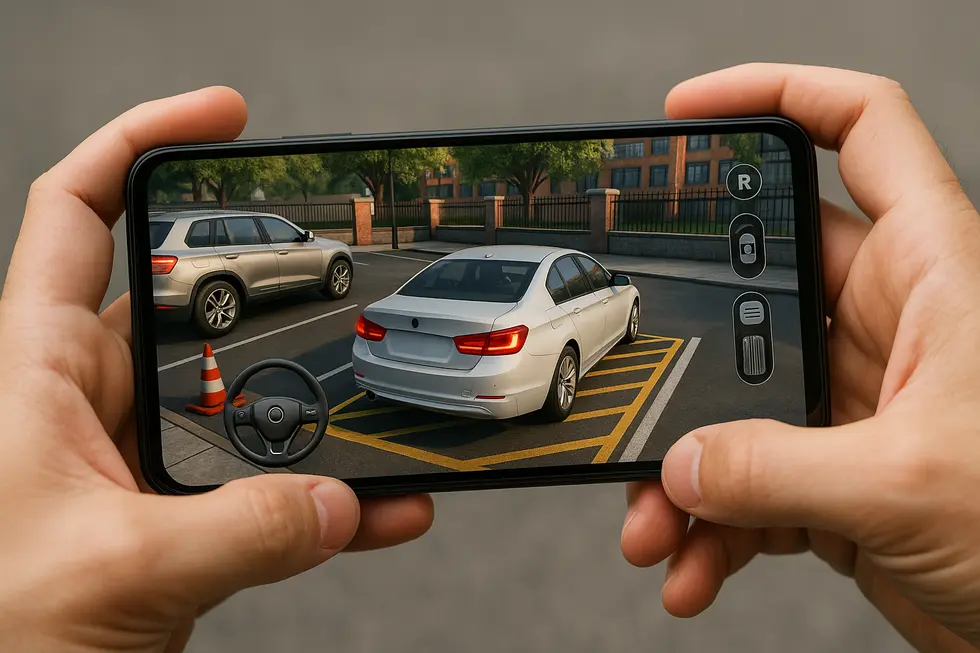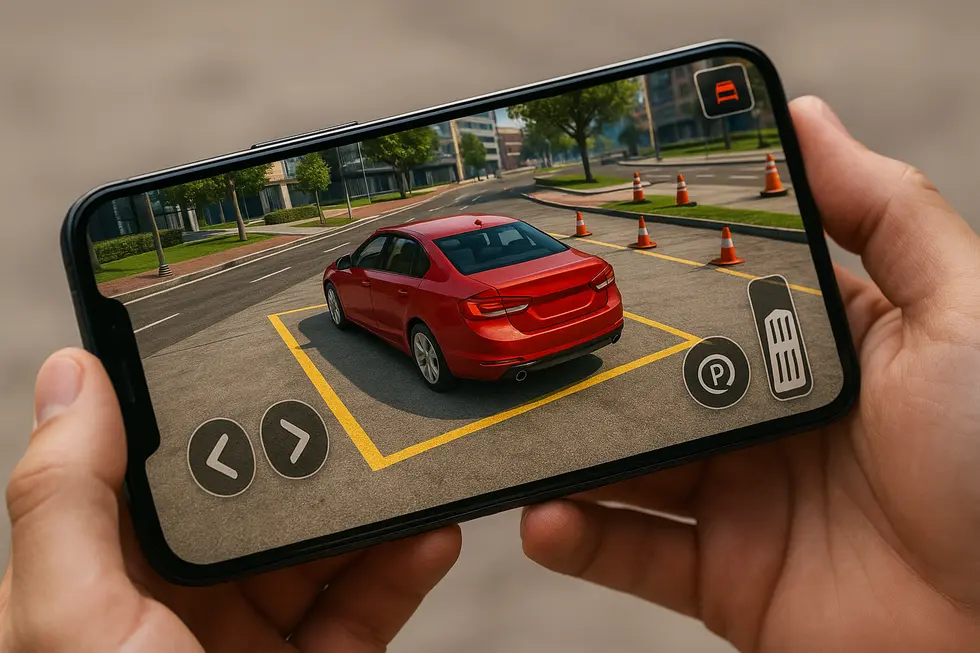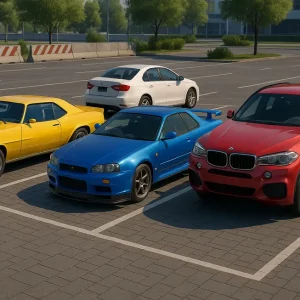Car parking simulation games have become a staple for Android users looking for engaging and realistic gameplay. These games offer a unique blend of entertainment and skill development, allowing players to simulate the challenges of parking various vehicles in complex environments. The ease of free downloads on the Android platform makes these games accessible to a wide audience. This article explores the features, gameplay mechanics, and user experience of car parking simulation games available for Android devices.
Simulation Realism and Gameplay Mechanics in Car Parking Games for Android

1. Mastering Motion: The Role of Realistic Physics Engines in Car Parking Simulations
In the detailed world of car parking simulation games on Android, a realistic physics engine forms the backbone of gameplay realism and engagement. By mimicking the intricate laws of physics, these engines provide the canvas upon which developers paint dynamic and immersive player experiences. Whether parking a sedan in a cramped urban alley or maneuvering a massive truck into a loading bay, the physics engine ensures that each vehicle responds to player inputs in a manner that feels both natural and challenging.
At its core, a realistic physics engine implements several key functionalities that help simulate the world as it exists off-screen. Dynamics simulation lies at the heart of this, where the engine calculates how objects—vehicles, in our case—respond to varying forces. These forces include gravity which gives weight to the vehicles, and friction which influences how tires grip the roadway. Moreover, every intricate player command is translated into virtual motion, thanks to the engine’s ability to process and apply forces such as drag and impulses, crafting an authentic driving experience in every simulated turn or stop.
Integral to realism is the engine’s ability to handle collision detection. For a car parking game, this means players cannot nonchalantly drive through virtual barriers or other vehicles without consequence. The engine spots when a player’s car comes into contact with another object, whether it be a late-night date’s car in the adjacent parking slot or the frustrating shopping cart buffering the rear bumper. It identifies intersections meticulously and prevents physical anomalies from disrupting gameplay.
Once collisions are identified, the engine engages in collision response, working to resolve the clashes between objects. This could involve calculating the bounce impact, modeling friction at the point of contact, and ensuring that objects do not overlap implausibly. It is these nuanced considerations that heighten the player’s sense of immersion, allowing them to predict and react in real-time, similar to real-world driving.
Of course, perfect mimicry of the physical world in the digital realm is bound by constraints—primarily computational ones. Developers often simplify collision geometry and overlook secondary—but often non-trivial—effects like surface moisture or tire wear, in order to maintain seamless and responsive gameplay. Yet, ongoing advancements in this field continue to push the boundaries of what’s possible, striving to bring more accurate simulations to users without sacrificing performance.
The essential role played by realistic physics engines in car parking simulations cannot be overstated. By bringing the principles of physics into the digital playground, they not only enrich the authenticity of virtual environments but also deepen the engagement for every player. For more on the intricate design of physics engines, Lark’s Glossary on Physics Engines provides a comprehensive look into their development and implementation.
2. Mastering Complex Parking Challenges: The Role of Realistic Physics Engines
In the realm of car parking simulations for Android, challenging parking scenarios are the crucible where players’ skills are truly refined. At the heart of these scenarios lies a sophisticated and realistic physics engine, which not only simulates the vehicle’s behavior but also enriches the gameplay experience by replicating real-world environments. These engines are the unsung heroes that transform a simple game into a captivating simulation that demands precision, strategy, and adaptability.
A physics engine is essentially a digital architect of reality, orchestrating the laws of physics to craft virtual worlds where vehicles behave as they would in the real world. This involves a meticulous dance of mathematical algorithms that compute forces, velocities, and positions, projecting them onto every frame of the simulation. This translates into realistic car handling, where acceleration, steering, and braking are affected by road conditions, car mass, and other environmental factors.
Immersive Vehicle Dynamics
The dynamic nature of these physics engines introduces various elements such as gravity, friction, and drag, all of which contribute to the game’s realism. Gravity determines how a car clings to the road, while friction necessary for both acceleration and deceleration adds layers of strategy as players maneuver their vehicles. Drag, although often subtle, plays a critical role as it interacts with car speed, demanding players to calculate optimal angles and velocities.
Parking scenarios in these simulations are not just about parking a car within the lines; they evolve into puzzles that require understanding the physics at play. The engines track every nuance, from the precise moment where the car’s tires hit a puddle—altering friction—to how momentum shifts the car’s trajectory as it enters a tight corner. Such detailed simulation requires players to utilize not just reflexes but strategic planning.
Colllision and Its Calculated Response
One of the triumphs of these engines is how they handle collision detection and response. Players are tasked with avoiding obstacles, but when collisions do occur, the physics engine determines how virtual bodies react—whether they bounce, slide, or crumple—all based on calculated responses governed by principles like mass and restitution. It’s this interplay of physics principles that elevates the immersion, creating a seamless challenge as players engage with environmental interactions.
Successful navigation and parking require a deep engagement with these realistic physics-driven nuances. Whether squeezing into a tight spot or avoiding a careless pedestrian, these experiences hinge on the seamless integration of dynamic physics, creating simulations that are as challenging as they are rewarding. Car parking games like Car Parking Multiplayer exemplify how leveraging advanced physics engines can offer players a rich tapestry of challenge and satisfaction, keeping them coming back for more.
Thus, these engines serve as the backbone of car parking games, enabling developers to craft intricate scenarios that test the mettle of any player aiming for perfection. Their contribution is not merely in visual authenticity but in deep, engaging gameplay that mirrors the complexity and unpredictability of real-world driving conditions.
User Experience and Interface Design in Car Parking Simulation Apps

1. Seamless Navigation: Mastering Intuitive Controls in Car Parking Simulations
In the realm of car parking simulation apps for Android, intuitive controls serve as the cornerstone of user interface design, ensuring that players can easily dive into the game without the burden of overwhelming instructions or a steep learning curve. These controls are engineered to mirror the natural interactions users are accustomed to in real life, thereby facilitating a seamless gameplay experience.
Intuitive controls in car parking simulations are primarily built on simplicity and naturalness. The idea is for controls to operate in a way that feels instinctually right, reducing cognitive load and allowing users to engage with the app fluidly. When players are steering through narrow alleys or reversing into tight parking spots, the controls respond with precision, aligning closely with their real-world expectations—much like turning a physical steering wheel or adjusting pedals.
A critical component of intuitive design is its ability to leverage prior user experience. By mimicking physical objects and behaviors—think of swiping on a touchscreen akin to turning a car key or adjusting a side mirror—the apps tap into pre-existing knowledge, streamlining the learning process. For example, drag-and-drop features on touchscreens reflect the tactile experience of handling actual objects, making navigation through the game environment feel as familiar as rearranging items on a desk.
Moreover, these user interfaces provide clear feedback and communication. In a parking simulation game, this might manifest as visual indicators that mimic the car’s orientation and surroundings, akin to how mirrors and sensors in a real vehicle inform drivers of their spatial dynamics. Such feedback ensures that users understand the current context of their actions at a glance, an essential feature when navigating complex parking simulations or dealing with unexpected in-game events.
Another enhancement to intuitive control is the ability for user customization. By allowing players to adjust sensitivity settings or configure control layouts to their liking, users gain a heightened sense of agency and comfort. This personalization enables them to synchronize the game’s handling with their natural inclinations, thereby reinforcing the intuitive nature of the interaction.
These elements collectively prioritize user-centered design principles, focusing on ease of use, immediate understanding, and natural interaction. By doing so, car parking simulation apps ensure that users are not just passive participants but are actively engaged in a realistic, rewarding gaming experience. Through intuitive controls, these apps transcend traditional gaming boundaries, delivering a user interface that is both functional and instinctively aligned with user expectations.
For those interested in experiencing a wide range of car parking challenges with intuitive controls, platforms like Car Parking Multiplayer provide a diverse and engaging environment where these principles come to life.
2. Intuitive Control Systems: Enhancing User Engagement in Interactive Environments
In the vibrant world of car parking simulation apps, the efficacy of intuitive control systems can significantly amplify the immersive experience for users. At the core of intuitive controls lies their ability to replicate real-world interactions, making the digital experience feel both engaging and natural.
A fundamental element in these apps is how these controls translate real-world driving mechanics into virtual environments. By mimicking the operation of actual vehicle controls, users are naturally guided by their own experiences, allowing them to focus on the enjoyment of the game, rather than being bogged down by complex instructions or misunderstandings.
The Seamless Integration of Real and Digital
Designers of car parking simulation games for Android devices are adept at leveraging core principles of intuitive design to enhance player engagement. These principles are rooted in how users interact daily with the physical world. Consider how natural it feels to swipe and tap on a touch screen—this mirrors the authentic interactions one experiences when operating a vehicle.
Further facilitating user engagement are features like clear communication, where the interface provides instant feedback to the player. Whether attempting a tricky parking maneuver or navigating a tight space, instant visual or audio cues guide the user, affording them confidence and bolstering the game’s interactive feel. Such rapid feedback is critical, especially in accurate simulations where every move mirrors real-world outcomes.
Similarly, the principle of physical mirroring comes into play, where the on-screen layout and vehicle response are designed to replicate real-life conditions. This alignment between digital feedback and physical expectations reinforces user trust and reduces cognitive load, allowing gamers to make decisions instinctively.
Universal Accessibility and Rapid Learning
In creating a universally accessible experience, rapid learning is pivotal. Car parking simulation apps are designed with a wide user base in mind: from novices to seasoned gamers. By ensuring that these games can be picked up and played with minimal instruction, they cater to players of all skill levels. This accessibility, paired with the intuitive nature of controls, broadens their appeal, ensuring that even as users advance, they find satisfaction in mastery attained through practice and natural gameplay interactions.
Such design choices reveal their worth through improved user satisfaction and ultimately, enhanced return on investment for developers. As intuitive controls improve gameplay efficiency and user enjoyment, they also reduce churn rates and support long-term user retention. Consequently, when controls effortlessly meet user expectations, the perceived value of the app increases, reflecting positively on the user experience.
The development and implementation of intuitive control systems in car parking simulation games not only enhance the gameplay experience but also contribute significantly to the growing popularity of these apps on the Android platform. Users appreciate how these systems align with their instinctual responses, fostering a seamless blend of fun and challenge that keeps them engaged.
For those interested in exploring a multiplayer experience, games such as Car Parking Multiplayer showcase how intuitive controls support interactive environments where users can compete or collaborate in real-time, highlighting the importance of user-centric design in maintaining an engaging and rewarding gaming environment.
Car parking simulation games for Android provide a blend of fun and challenge, making them a popular choice among mobile gamers. Their realistic gameplay mechanics and well-designed interfaces enhance the gaming experience, while the accessibility of free downloads ensures that anyone can join the fun. Whether you are looking to improve your parking skills or merely entertain yourself with a captivating challenge, these games offer something for everyone.


 Table Contents
Table Contents 


